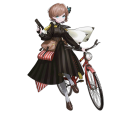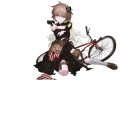Ranking of this Doll's specs relative to other Dolls of the same type.
HP-35: Difference between revisions
AutumnsFall (talk | contribs) No edit summary |
No edit summary |
||
| (5 intermediate revisions by 4 users not shown) | |||
| Line 9: | Line 9: | ||
|artist = {{artist name|れおえん}} | |artist = {{artist name|れおえん}} | ||
|fullname = Fabrique Nationale Browning Hi-Power | |fullname = Fabrique Nationale Browning Hi-Power | ||
|voiceactor = | |voiceactor = {{voice actor name|Murakawa Rie}} | ||
|releasedon = {{doll_server_alias|server=CN|alias=HP-35}}, {{doll_server_alias|server=TW|alias=HP-35}}, {{doll_server_alias|server=KR|alias=HP-35}} | |releasedon = {{doll_server_alias|server=CN|alias=HP-35|year=2020|month=4}}, {{doll_server_alias|server=TW|alias=HP-35}}, {{doll_server_alias|server=KR|alias=HP-35}}, {{doll_server_alias|server=EN|alias=HP-35}}, {{doll_server_alias|server=JP|alias=HP-35}} | ||
|weaponinfo = | |weaponinfo = | ||
| Line 19: | Line 19: | ||
Browning would build two different prototypes for the project. One was a simple blowback design, while the other featured a locked-breech recoil system. Both prototypes utilized a new staggered magazine design to increase capacity without unduly increasing the pistol's grip size or magazine length. The locked-breech design was selected for further development and testing. This model was striker-fired, and featured a double-column magazine that held 16 rounds. Ultimately, France decided not to adopt the pistol, instead selecting the conceptually similar but lower-capacity Modèle 1935 pistol. | Browning would build two different prototypes for the project. One was a simple blowback design, while the other featured a locked-breech recoil system. Both prototypes utilized a new staggered magazine design to increase capacity without unduly increasing the pistol's grip size or magazine length. The locked-breech design was selected for further development and testing. This model was striker-fired, and featured a double-column magazine that held 16 rounds. Ultimately, France decided not to adopt the pistol, instead selecting the conceptually similar but lower-capacity Modèle 1935 pistol. | ||
After the French trials, Browning returned to work | After the French trials, Browning returned to work. He remained at FN, tinkering with the pistol prototype, until he died in 1926, several years before the design was finalized. In 1928, when the patents for the Colt Model 1911 had expired, the Belgian firm appointed Dieudonne Saive as the engineer in charge of finishing the Browning pistol. Saive, who would later become FN's chief engineer, combined the best features of the Colt 1911, Browning's prototypes, and a number of his own ideas into an entirely new 9mm handgun. By 1931, the Browning Hi-Power design incorporated a shortened 13-round magazine, a curved rear grip strap, and a barrel bushing that was integral to the slide assembly.<ref name = "Hi Power Wiki">[https://en.wikipedia.org/wiki/Browning_Hi-Power Wikipedia article on the Browning Hi-Power]</ref> | ||
By 1934, the Hi-Power design was complete and ready to be produced, and it would be adopted by Belgium for military service in 1935 as the Browning P-35. Browning Hi-Power pistols were used during World War II by both Allied and Axis forces. After occupying Belgium in 1940, German forces took over the FN plant. German troops subsequently used the Hi-Power, having assigned it the designation Pistole 640(b)("b" for belgisch, or "Belgian"). Following the end of World War 2, FN would continue to produce the Hi-Power, and by the 1990's it had been adopted as the standard service pistol by over 50 armies in 93 countries. | By 1934, the Hi-Power design was complete and ready to be produced, and it would be adopted by Belgium for military service in 1935 as the Browning P-35. Browning Hi-Power pistols were used during World War II by both Allied and Axis forces. After occupying Belgium in 1940, German forces took over the FN plant. German troops subsequently used the Hi-Power, having assigned it the designation Pistole 640(b)("b" for belgisch, or "Belgian"). Following the end of World War 2, FN would continue to produce the Hi-Power, and by the 1990's it had been adopted as the standard service pistol by over 50 armies in 93 countries. | ||
Latest revision as of 16:05, 5 August 2024
| HP-35 | Quotes | Live2D |
HP-35 303   | |
| Gun Information | |
|---|---|
| Full name | Fabrique Nationale Browning Hi-Power |
| Country of origin | United States, Belgium |
| Manufacturer | Fabrique Nationale (FN), John Inglis & Co., Browning Arms |
| Game Information | |
| Faction | Griffin & Kryuger |
| Manufactured / Revised by |
I.O.P. |
| Voice actor | Murakawa Rie |
| Artist | れおえん |
| Released on | CN (2020-4), TW, KR, EN, JP |
| Chibi Animation | |
| Variant:
Click the marked area to switch between animations. For details regarding animations, please see Animations on the Wiki. | |
| View page template | |
How to obtain[edit]
NORMALHEAVY Timer 1:35:00. See T-Doll Production for details.
DROP Not obtainable as a drop.
REWARD Not obtained as a reward
Exclusive Equipment[edit]
There is no exclusive equipment for this T-Doll.
Union Skill[edit]
There is no union skill for this T-Doll.
Stats / Data[edit]
| 38(x1) → 76(x1) / 380(x5) | 10(x1) / 30(x5) | 10(x1) / 30(x5) |
|
| ||||||||
|
| ||||||||
| 15 | 0 | ||||||||
| 20% | 50% | ||||||||
| 15 |
Ranking of this Doll's specs relative to every other Doll.
Weapon Background[edit]
The Browning Hi-Power is a single-action, semi-automatic handgun manufactured by FN Herstal of Belgium and Portugal and under licence by Fabricaciones Militares (FM) of Argentina. The Hi Power name alludes to the 13-round magazine capacity, almost twice that of contemporary designs. The Hi-Power is one of the most widely-used military pistols in history, having been used by the armed forces of over 50 countries. It remains one of the most influential pistols in the history of small arms, with many clones being produced and many modern pistols borrowing design/mechanical elements first introduced with this design.
The Hi-Power is based on a design by American firearms inventor John Moses Browning. Following the conclusion of the First World War, the French military would hold trials for a new service sidearm. A number of arms manufacturers would seek to participate at these trials, among them FN Herstal of Belgium. FN had worked with Browning on pistol designs in the past, and so sought to commission him to work on a new semi-automatic pistol that met the requirements of the French trial. At the time FN approached him, Browning had sold the rights to his massively successful M1911 pistol design to Colt, and he was forced to come up with an entirely new design that didn't utilize elements from prior patents.[1]
Browning would build two different prototypes for the project. One was a simple blowback design, while the other featured a locked-breech recoil system. Both prototypes utilized a new staggered magazine design to increase capacity without unduly increasing the pistol's grip size or magazine length. The locked-breech design was selected for further development and testing. This model was striker-fired, and featured a double-column magazine that held 16 rounds. Ultimately, France decided not to adopt the pistol, instead selecting the conceptually similar but lower-capacity Modèle 1935 pistol.
After the French trials, Browning returned to work. He remained at FN, tinkering with the pistol prototype, until he died in 1926, several years before the design was finalized. In 1928, when the patents for the Colt Model 1911 had expired, the Belgian firm appointed Dieudonne Saive as the engineer in charge of finishing the Browning pistol. Saive, who would later become FN's chief engineer, combined the best features of the Colt 1911, Browning's prototypes, and a number of his own ideas into an entirely new 9mm handgun. By 1931, the Browning Hi-Power design incorporated a shortened 13-round magazine, a curved rear grip strap, and a barrel bushing that was integral to the slide assembly.[2]
By 1934, the Hi-Power design was complete and ready to be produced, and it would be adopted by Belgium for military service in 1935 as the Browning P-35. Browning Hi-Power pistols were used during World War II by both Allied and Axis forces. After occupying Belgium in 1940, German forces took over the FN plant. German troops subsequently used the Hi-Power, having assigned it the designation Pistole 640(b)("b" for belgisch, or "Belgian"). Following the end of World War 2, FN would continue to produce the Hi-Power, and by the 1990's it had been adopted as the standard service pistol by over 50 armies in 93 countries.
While the Hi-Power remains an excellent design, since the early 1990s it has been eclipsed somewhat by more modern designs which are often double-action and are manufactured using more modern methods. After 82 years of continuous production, the Hi-Power was discontinued in 2017 by Browning Arms, but it remained in production in some countries, under license.
Character Background
She freely switches between an elegant and romantic mode in daily life and a vicious and ruthless mode when on missions. When she's free, she adventures into unexplored corners. Her favorite transportation tool is the bicycle, but her bike-riding skills are frightening, and she is an infamous roadway killer. Usually, nobody dares come within 2 meters of her when she's on her bike.
Gallery
Main artwork
Gallery consisting of artworks used primarily in-game. For information on how to obtain certain costumes, see Skin Catalogue.
-
Profile image
-
Full artwork
-
Full damaged artwork
-
"Little Glider" Full artwork
-
"Little Glider" Full damaged artwork
Alternative artwork
Alternate gallery consisting of artworks with slight alterations as well as miscellaneous artworks.
-
Official character sheet for HP-35
-
"Childhood Fantasies" Login wallpaper illustrated by 薯子Imoko
References[edit]
| List of T-Dolls |
|---|



















